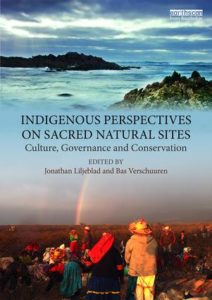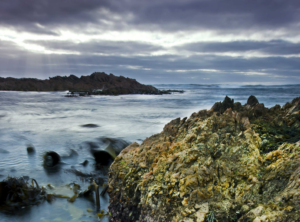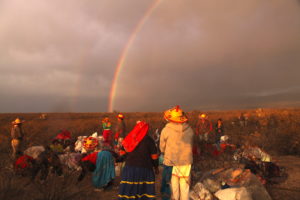
Seo an tAirteagal atá le feiceáil ar an Nuachtlitir Nuachtlitir Taighde ar Láithreáin Naofa Márta 2019 Eisiúint.
le Jonathan Liljeblad
Ardú na gCeart Dúchasach
Ag tosú sa dara cuid den 20ú haois agus ag leanúint ar aghaidh isteach sa 21 st , bhailigh iarracht dhomhanda móiminteam trí bhealaí éagsúla chun coincheap na gceart Dúchasach a aithint agus aghaidh a thabhairt air. Tá pobail dhúchasacha i láthair ar fud an domhain agus bhí siad ann roimh chóras domhanda reatha na náisiún-stáit. Lean gach náisiún-stáit a chur chuige féin i leith cultúir Dúchasacha, éagsúil i méid idir ghníomhartha a chuimsíonn speictream ó athmhuintearas agus de réir imeallú agus díothú iomlán. An t-údarás trína ndéileálann náisiúin stáit le Dúchasaigh
tá pobail ceangailte le stair impireachtaí Eorpacha atá sna 1648 Chruthaigh Peace Westphalia domhanda
córas bunaithe ar náisiúin a bhfuil ceannas acu, ina bhfuil smacht eisiach ag náisiún-stáit
daonra ar fad, críoch, and resources within its borders.
The conceptual primacy of nation-state sovereignty served to remove Indigenous civilizations from the
global order and subjugated them to non-Indigenous power, first from colonial administration and then
later national governments. The past few decades, áfach, has hosted a range of movements to erode
the status of nation-state sovereignty. Such erosion has come both from above, in the sense of a
burgeoning growth in the number of international institutions and international treaties that brought
nation-states within the rules of an expanding array of international regimes covering a host of issue
areas, and from below, in the sense of non-state social movements and social networks operating
transnationally to advance particular causes against nation-states. Among the issue areas and causes
has been the subject of Indigenous peoples.
Much of the international attention on Indigenous peoples has centered on the question of Indigenous rights. Of particular note was the work of United Nations (A) institutions such as the Human Rights
Council (HRC), Office of the High Commissioner for Human Rights (OHCHR), and the Working Group on Indigenous Populations (WGIP). Their efforts led to the formation of the UN Permanent Forum on
Indigenous Issues (PFII) and articulation of Indigenous rights in international law, both through existing
human rights treaties like the International Covenant on Economic, Social, and Cultural Rights (ICESCR)
or dedicated Indigenous rights instruments like the International Labor Organization (ILO) Convention
Concerning Indigenous and Tribal Peoples (Níl. 169) or the UN Declaration on the Rights of Indigenous
Peoples (DRIP). Concurrent to such broad global efforts has been more issue-specific activities such as
the World Heritage system, whose advisory bodies—the International Centre for Study of Preservation
and Restoration of Cultural Property (ICCROM), International Council on Monuments and Sites
(ICOMOS), and International Union for Conservation of Nature (IUCN)—have issued guidelines to
promote the existence and exercise of Indigenous rights to cultural and natural heritage.
Potential Issues in Indigenous Rights
Much of the work for Indigenous rights is driven by a desire to resolve the legacies of harms done in the past to Indigenous civilizations under the Westphalian system. While laudable, it is still insufficient. If the ulterior purpose is a resolution of the past, then it is not enough to implement a rights-based system. Beyond the confines of a rights-based system, there is the larger space of worldviews spanning perspectives drawn from different values, unique experiences, and diverse ways of thinking. Such phenomena are important because they direct decisions by various peoples about how they understand life and what they want from it. In essence, they explain why people believe what they believe and why they do what they do. Dá bhrí sin, they offer some understanding about purpose, not just with respect to the application of rights but to the manner of living that rights are supposed to protect.
The work of a rights-based system carries the risk of conflict in that an aggrieved party claims a right
either to halt a perceived aggression from another party or to force some ameliorative action from
another party, suggesting action with a tenor of antagonization. The danger of conflict only furthers the harmful legacies of the past, which pitted imperial powers and then later national governments in
antagonistic relationships with Indigenous peoples. The motivation to resolve the legacies of the past
calls for work to prevent or mitigate conflict instead of sustaining or inciting it. As a result, it is necessary to work on deeper levels to bring non-Indigenous and Indigenous perspectives together.
Finding Greater Resolution
There are examples of such kinds of work being done. Within cultural and environmental issue areas, a
host of actors are working to build relationships between non-Indigenous and Indigenous perspectives
to facilitate management systems over sites carrying cultural and environmental significance at local,
náisiúnta, and international levels. Of particular note, the World Heritage system has sought to promote
the involvement of Indigenous actors in decision-making with respect to culture and environment
associated with Indigenous peoples, articulating principles such as self-determination, free prior
informed consent (FPIC), and equal treatment in governance systems.
Here too, áfach, some caution should be noted. If they are to be effective in resolving the legacies of the past, the above efforts must operate to nurture relationships with social capital—that is, meaningful relationships involving trust, communication, and familiarity. This is not to suggest that there is always consensus, but rather to provide a basis for finding mutually agreeable outcomes or otherwise, at minimum, a means of finding peaceful co-existence. Building sustainable relationships calls for efforts to integrate diverse perspectives in discourse, such as encouraging Indigenous voices to be heard alongside non-Indigenous voices and, more importantly, listening to Indigenous perspectives as having value commensurate to non-Indigenous ones.

The recently published book: Indigenous Perspectives on Sacred Natural Sites: Cultúr, Governance and Conservation, edited by: Jonathan Liljeblad and Bas Verschuuren
A reflection of the above philosophy is the book entitled Indigenous Perspectives on Sacred Natural Sites: Cultúr, Governance and Conservation (2019, Routledge, Jonathan Liljeblad and Bas Verschuuren, eds.). The motivation behind the book is to facilitate self-expression by Indigenous authors about their respective approaches towards sacred natural sites. Tá an córas Oidhreachta Domhanda clár oibre arna saothrú le blianta beaga anuas mar thacaíocht do chaomhnú do shuímh nádúrtha naofa, agus na hiarrachtaí Chuimsigh láithreáin nádúrtha naofa na bpobal Dúchasacha. Go leor den obair a foilsíodh, áfach, Tagann den chuid is mó ó údair neamh-Dúchasacha, agus mar sin mar thoradh ar chásanna de saineolaithe gan Dúchasacha scríobh faoi chultúir Dúchasacha agus an t-eisiamh mar thoradh ar guthanna dúchasacha ó breithnithe ar a n-oidhreacht féin. Déanann an ábhar na suíomh naofa íogair, particularly in situations when it is central to historically marginalized Indigenous cultures. In the spirit of resolving the legacies of the past and finding a more promising future, the book seeks to place Indigenous voices alongside existing non-Indigenous work on sacred natural sites and thereby enrich considerations within this area of conservation. The authors encourage other efforts pursuing similar goals and welcome discussions on ways to do so.








